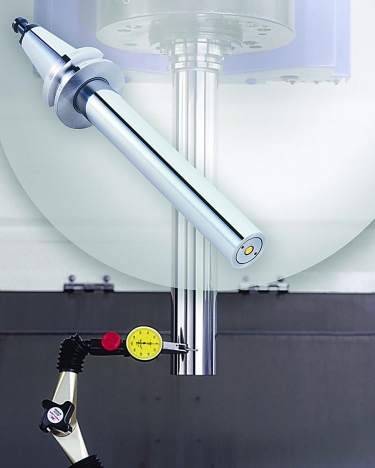Machine Maintenance and Monitoring Tips
Machine maintenance is critical to metalcutting. Because of their manual nature, certain tasks can be hard and time-consuming, taking up valuable spindle time. These efforts are necessary, however, to ensure consistent performance of machinery and tooling.
Left to work for extended periods without attention, spindles and other machine components may pass on problems to parts and cutting tools. I often see how frustratingly difficult these issues are to diagnose.
The best plan is to schedule routine maintenance and testing, especially when applying premium tools. What many people first think is tool trouble frequently can be resolved with cleaning, more vigilant monitoring of machinery or both. The following suggestions are for maintenance and monitoring.

Dyna Test is a precision test bar for static accuracy of a machine spindle. Using Dyna Test bars for regular inspection helps identify potential problems.
Verify Taper Accuracy
The spindle is a key link in the machining chain. Whether it’s an errant chip, fluid buildup or heating wear, part quality and machining efficiency can be hurt. Visual checks are not enough, and neither is an occasional wipe-down. This is where a taper gauge comes in handy. By applying a blue layout dye, inserting it into the spindle and removing it, inconsistencies that cause poor contact of the spindle taper with tool holders are revealed. This information enables targeted cleaning and repair.
Test Static Accuracy
Another way to confirm spindle performance or ensure that bearings are holding up is to inspect the accuracy of spindle movement. Any runout in a spindle will be amplified as it extends through the tool and into the part. Similarly, if z-axis movement is not parallel, users will see the resulting imperfections on parts. I recommend using a test bar that’s inserted into the spindle and a touch probe to measure movement. Simply spinning the spindle slowly or moving it along the z-axis while the probe is on the bar will reveal any issues.
Align Automatic Toolchangers
Essentially an entry-level form of automation, ATCs are a popular way to improve setup and changeover efficiency. As with any other machine component, accuracy matters. Misalignment between the spindle and ATC gripper can damage the spindle taper, and clamping a misaligned holder may increase runout and shorten tool life. ATC alignment tools can help realign the center point between the spindle and gripper. They also could realign the gripper with tool magazine pockets.
Level Worktables
A small imperfection in a spindle taper can interfere with a cut, and the same can be said for a table. Just like adjusting a tool while it’s in a spindle is tricky, adjusting a table while verifying that it is level is easier said than done. Leveling systems with two-axis simultaneous detection and extreme optical precision that send a remote signal to a device outside the machine have been developed to simplify this process. The operator can adjust the table and see the results in real time.
Test Retention Force
The retention force of a machine tool spindle is critical to imparting fine surface finishes and achieving acceptable tool life, but the pulling force produced by the clamping device of machine tools can deteriorate due to degradation of disc springs or wear of amplifier components. Testing retention is most easily and accurately performed with a tool clamp measuring device that accepts a holder and pull stud, which is inserted into a spindle and then provides a reading.
Performing these five maintenance steps can go a long way toward ensuring that capital investments continue to pay off, tool life is extended and parts are done right the first time. Don’t let what is preventable cost you money.



Did you find this interesting or helpful? Let us know what you think by adding your comments or questions below.